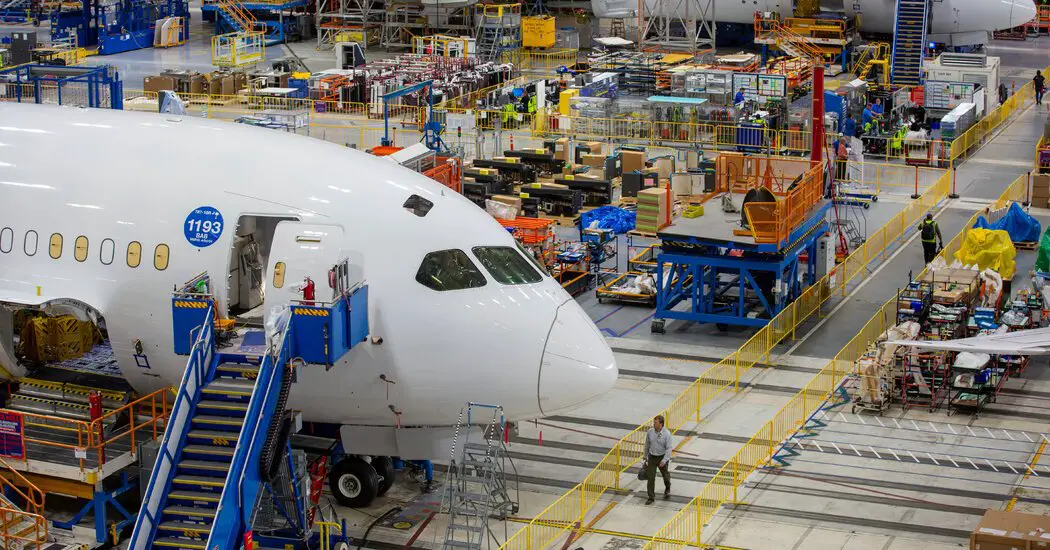Boeing sought on Monday to reassure the public of the safety of its 787 Dreamliner plane days before a whistle-blower is scheduled to testify before Congress about his concerns regarding the jet’s structural integrity.
In a briefing for reporters at the factory in North Charleston, S.C., where the plane is assembled, two top Boeing engineers said the company had conducted exhaustive tests, inspections and analyses of the plane, both during its development and in recent years, and found no evidence that its body would fail prematurely.
The presentation came just under a week after The New York Times reported the allegations by the whistle-blower, Sam Salehpour, who works as a quality engineer at Boeing and is set to testify before a Senate panel on Wednesday. Mr. Salehpour said that sections of the fuselage of the Dreamliner, a wide-body plane that makes extensive use of composite materials, were not properly fastened together and that the plane could suffer structural failure over time as a result. The Federal Aviation Administration is investigating his allegations.
Mr. Salehpour’s claims instantly created another public-relations problem for Boeing, which has been facing intense scrutiny over its manufacturing practices after a panel came off a 737 Max during an Alaska Airlines flight in January.
Mr. Salehpour said that the gaps where sections of the Dreamliner’s fuselage were fastened together did not always meet Boeing’s specifications, something that he said could weaken the aircraft over time. The Boeing engineers disagreed with his assessment, without naming him. They said the plane had gone through extensive testing that showed that, in a vast majority of cases, the gaps met the specifications. Even if the gaps exceeded the specifications by a reasonable amount, they would not affect the plane’s durability, the engineers added.
“Not only did we interrogate those airframes — we were taking out fasteners, we were looking for damage, we’re also doing the approval inspections to understand the build condition, and we didn’t find any fatigue issues in the composite structure,” said Steve Chisholm, a vice president and the functional chief engineer for mechanical and structural engineering at Boeing.
Mr. Chisholm said the company had put the Dreamliner through extensive tests that turned up no evidence of fatigue in the jet’s composite structure. A 787 airframe was subjected to testing that put it through 165,000 “flight cycles,” the equivalent pressurization and depressurization of as many flights. That figure far exceeded the plane’s expected life span and the airframe still showed no signs of fatigue, he said.
The 787 plane with the highest number of cycles belongs to a Japanese airline, All Nippon Airways, which received it in late 2012, according to Boeing. That aircraft has been through about 16,500 cycles, the company said.
In a statement on Monday, Debra S. Katz, a lawyer for Mr. Salehpour, urged caution about accepting Boeing’s assertions about the Dreamliner as fact.
“We cannot speak or respond to data that we haven’t seen, but Boeing has always said ‘just trust us’ when it comes to safety,” Ms. Katz said. “It’s clear that standard is no longer sufficient, and any data provided by Boeing should be validated by independent experts and the F.A.A. before it is taken at face value.”
Mr. Salehpour is scheduled to testify on Wednesday before the Senate Homeland Security and Governmental Affairs Committee’s investigations subcommittee. Separately that day, the Senate Commerce Committee is planning to hold a hearing with experts who were involved in producing a recent F.A.A. report that faulted Boeing’s safety culture.
Boeing began investigating problems with gaps in the Dreamliner about five years ago, eventually discovering that some between adjoining parts of the plane’s body did not meet its own specifications of being less than five-thousandths of an inch thick. That led the company to pause deliveries for about 18 months as it inspected its processes and planes, making changes where appropriate. That work involved removing thousands of fasteners from planes in its inventory and inspecting the size of the gap between the two materials each fastener held together.
The company said that about 1 percent of all gaps inspected failed to meet specifications. The company also said that research and testing over the past few years had found that the larger gaps posed no threat to the plane’s long-term durability.
The company noted that 671 Dreamliners had gone through thorough six-year maintenance checks, while eight had gone through 12-year checks, and it said that none of those checks found any signs of premature fatigue. Boeing said it did not believe that Dreamliners currently being flown by its customers were in need of any modification.

